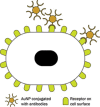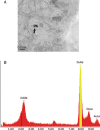Gold nanoparticles in cancer therapy
- PMID: 21743485
- PMCID: PMC4002534
- DOI: 10.1038/aps.2011.82
Gold nanoparticles in cancer therapy
Abstract
The rapid advancement of nanotechnology in recent years has fuelled a burgeoning interest in the field of nanoparticle research, in particular, its application in the medical arena. A constantly expanding knowledge based on a better understanding of the properties of gold nanoparticles (AuNPs) coupled with relentless experimentation means that the frontiers of nanotechnology are constantly being challenged. At present, there seems to be heightened interest in the application of AuNPs to the management of cancer, encompassing diagnosis, monitoring and treatment of the disease. These efforts are undertaken in the hope of revolutionizing current methods of treatment and treatment strategies for a multifactorial disease such as cancer. This review will focus on the current applications of AuNPs in cancer management.
Figures




Similar articles
-
Progress in research on gold nanoparticles in cancer management.Medicine (Baltimore). 2019 May;98(18):e15311. doi: 10.1097/MD.0000000000015311. Medicine (Baltimore). 2019. PMID: 31045767 Free PMC article.
-
A Nanotechnology-based Strategy to Increase the Efficiency of Cancer Diagnosis and Therapy: Folate-conjugated Gold Nanoparticles.Curr Med Chem. 2017;24(39):4399-4416. doi: 10.2174/0929867324666170810154917. Curr Med Chem. 2017. PMID: 28799495 Review.
-
The Basic Properties of Gold Nanoparticles and their Applications in Tumor Diagnosis and Treatment.Int J Mol Sci. 2020 Apr 3;21(7):2480. doi: 10.3390/ijms21072480. Int J Mol Sci. 2020. PMID: 32260051 Free PMC article. Review.
-
Current trends in using polymer coated gold nanoparticles for cancer therapy.Int J Pharm. 2015 Apr 30;484(1-2):252-67. doi: 10.1016/j.ijpharm.2015.02.038. Epub 2015 Feb 18. Int J Pharm. 2015. PMID: 25701627 Review.
-
Effective targeting of breast cancer cells (MCF7) via novel biogenic synthesis of gold nanoparticles using cancer-derived metabolites.PLoS One. 2020 Oct 6;15(10):e0240156. doi: 10.1371/journal.pone.0240156. eCollection 2020. PLoS One. 2020. PMID: 33022008 Free PMC article.
Cited by
-
Gold nanoparticles-induced cytotoxicity in triple negative breast cancer involves different epigenetic alterations depending upon the surface charge.Sci Rep. 2018 Aug 16;8(1):12295. doi: 10.1038/s41598-018-30541-3. Sci Rep. 2018. PMID: 30115982 Free PMC article.
-
Targeted Lymphoma Therapy Using a Gold Nanoframework-Based Drug Delivery System.ACS Appl Mater Interfaces. 2023 Feb 8;15(5):6312-6325. doi: 10.1021/acsami.2c17214. Epub 2023 Jan 26. ACS Appl Mater Interfaces. 2023. PMID: 36701696 Free PMC article.
-
Encapsulation for Cancer Therapy.Molecules. 2020 Mar 31;25(7):1605. doi: 10.3390/molecules25071605. Molecules. 2020. PMID: 32244513 Free PMC article. Review.
-
Gold nanoparticles in radiation research: potential applications for imaging and radiosensitization.Transl Cancer Res. 2013 Aug 1;2(4):280-291. doi: 10.3978/j.issn.2218-676X.2013.08.09. Transl Cancer Res. 2013. PMID: 25429358 Free PMC article.
-
Versatile Methodology to Encapsulate Gold Nanoparticles in PLGA Nanoparticles Obtained by Nano-Emulsion Templating.Pharm Res. 2017 May;34(5):1093-1103. doi: 10.1007/s11095-017-2119-1. Epub 2017 Feb 14. Pharm Res. 2017. PMID: 28197757
References
-
- Cancer [homepage on the Internet]. Geneva: World Health Organization. Accessed Oct 21, 2010. Available from: : http://www.who.int/cancer/en/ .
-
- Wagstaff KM, Jans DA. Nuclear drug delivery to target tumour cells. Eur J Pharmacol. 2009;625:174–80. - PubMed
-
- Boisselier E, Astruc D. Gold nanoparticles in nanomedicine: preparations, imaging, diagnostics, therapies and toxicity. Chem Soc Rev. 2009;38:1759–82. - PubMed
-
- Liu Y, Miyoshi H, Nakamura M. Nanomedicine for drug delivery and imaging: a promising avenue for cancer therapy and diagnosis using targeted functional nanoparticles. Int J Cancer. 2007;120:2527–37. - PubMed
-
- Lanone S, Boczkowski J. Biomedical applications and potential health risks of nanomaterials: molecular mechanisms. Curr Mol Med. 2006;6:651–63. - PubMed
Publication types
MeSH terms
Substances
LinkOut - more resources
Full Text Sources
Other Literature Sources

